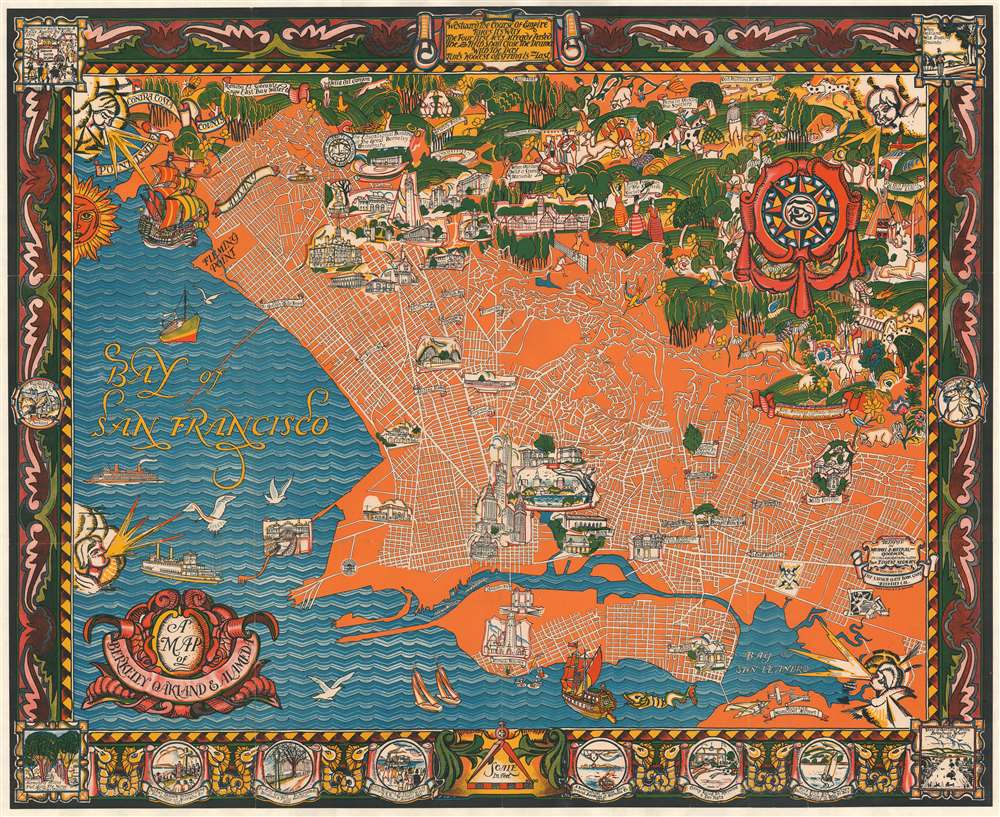This item has been sold, but you can get on the Waitlist to be notified if another example becomes available, or purchase a digital scan.
1930 Baltekal-Goodman Pictorial Map of Berkeley and Oakland, California
BerkeleyOakland-baltekalgoodman-1930
Title
1930 (undated) 35 x 43 in (88.9 x 109.22 cm) 1 : 34000
Description
Chromolithography
Chromolithography is a color lithographic technique developed in the mid-19th century. The process involved using multiple lithographic stones, one for each color, to yield a rich composite effect. Oftentimes, the process would start with a black basecoat upon which subsequent colors were layered. Some chromolithographs used 30 or more separate lithographic stones to achieve the desired effect. Chromolithograph color could also be effectively blended for even more dramatic effects. The process became extremely popular in the late 19th and early 20th centuries, when it emerged as the dominate method of color printing. The vivid color chromolithography produced made it exceptionally effective for advertising and propaganda imagery.Publication History and Census
This map was drawn and compiled by Michael A. Baltekal-Goodman and Eugene (Eugen) Neuhaus. Although undated, most conventional wisdom date it to about 1930, when Baltekal-Goodman was studying under Neuhaus, then a professor at Berkeley. It was prepared for the Sather Gate Book Shop, in Berkeley, and printed by Union Lithography of San Francisco and Oakland. Examples are uncommon on the market. The map is accompanied by its original envelope.CartographerS
Michael A. Baltekal-Goodman (January 7, 1903 - April 12, 1991) was Lithuanian-American artist, wood engraver, pastelist, and architect active in California in throughout the 20th century. Baltekal-Goodman was bor in in Lithuania and immigrated to the united states in 1921, settling in Berkeley California, where he studied at the UC Berkeley school of architecture. There is studied under Ray Boynton, Perham Nahl, and Eugen (Eugene) Neuhaus. He collaborated with Eugen Neuhaus on at least one map, a pictorial image of Berkeley, California. During the Great Depression, in the 1930s he was involved with the local WPA (Works Projects Administration). After graduating from UC, he worked for the architecture firm of Timothy Pflueger, Willis Polk, and Bernard Maybeck. He also collaborated with Diego Riviera, who painted him. Baltekal-Goodman died at his Berkeley home in 1991. More by this mapmaker...
Eugene (Eugen) Neuhaus (August 18, 1878 - October 29, 1953), was a German-American artist and professor active in Berkeley, California. Neuhaus was born in Barmen, Rhin Province, Germany. He studied at the Elberfield Realgymnasium, the Kassel Royal Art School, and the Berlin Royal Institute for Applied Arts. In worked as an art instructor at the Municipal Art School, Charlottenburg, Berlin, before emigrating to the United States in 1904. He was subsequently naturalized as a U.S. citizen in 1911. He began working with the University of California Berkeley in 1907, teaching in the drawing department from 1908. He became an assistant professor of decorative design in 1915, and upon the formation of the Department of Drawing and Art in 1920, he became assistant professor of art appreciation. Learn More...
Union Lithography Company (1888 - 1948) was a San Francisco and Oakland based printing concern active in the late 19th and early 20th centuries. The firm was originally founded 1888 by the former Providence, Rhode Island printer, Jennison Clifton Hall (March 22, 1840 - May 20, 1898), as J. C. Hall and Company. Previously, Jennison was running a firm in Providence partnered with John E. Bugbee under the imprint of Bugbee and Hall. J. C. Hall and Company was renamed Union Lithography sometime around 1890. Hall died unexpectedly of a heart attack in 1898, but the firm continued. The firm met with considerable success until its offices were destroyed during the 1906 San Francisco Earthquake. Later that year, to supplement their crippled printing capacity, Union purchased the Los Angeles Lithographic Company. Union was purchased by the H.S. Crocker and company in 1922, but retained its name until 1936, when the firms began publishing under the unified Crocker-Union imprint. The consolidated firm remained active until about 1948. Learn More...

